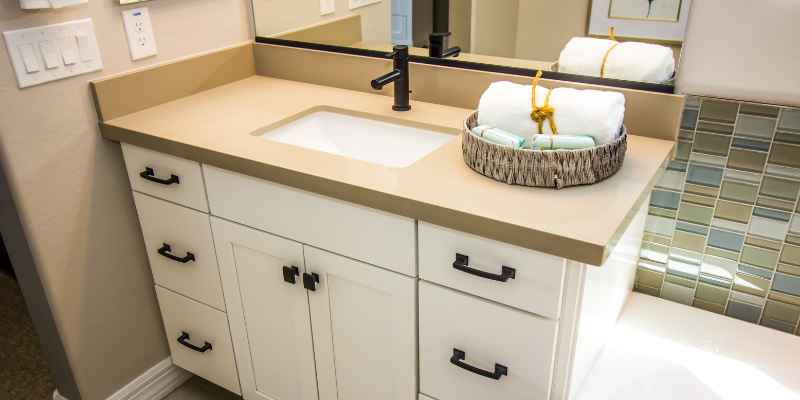To waterproof a wood vanity top, start by sanding the surface to remove any imperfections. Apply a high-quality wood sealant or waterproofing product evenly over the wood.
Waterproofing your wood vanity top is essential for longevity and aesthetic appeal. Wood is prone to water damage, which can lead to warping, staining, and mold growth. A well-sealed surface protects against spills and humidity, maintaining the integrity of the wood.
Various sealants are available, including oils, varnishes, and polyurethane. Choosing the right product depends on the desired finish and level of protection. Regular maintenance and reapplication will ensure your vanity top remains in excellent condition. This guide will help you understand the steps needed to effectively waterproof your wood vanity top, ensuring it lasts for years to come.
Introduction To Wood Vanity Tops
Wood vanity tops add warmth and style to any bathroom. They create a cozy atmosphere and enhance overall decor. Many people love the natural look of wood. It can easily match different bathroom styles.
Wood surfaces in wet areas face challenges. Moisture can cause wood to swell or warp. Mold and mildew might also develop if not treated properly. Regular maintenance is necessary to keep the wood in good shape. Proper sealing can help protect against water damage.
| Challenges | Solutions |
|---|---|
| Swelling | Use a high-quality sealant. |
| Warping | Avoid excessive water exposure. |
| Mold Growth | Clean with mold-resistant cleaners. |

Why Waterproofing Is Essential
Waterproofing is crucial for wood vanity tops. It protects against water damage. This protection helps increase longevity and durability. Regular exposure to moisture can cause wood to warp or rot. Waterproofing prevents these issues and extends the life of your vanity.
Maintaining the aesthetic appeal of your wood vanity is important. A well-protected surface looks beautiful for years. Without proper waterproofing, stains and discoloration can occur. Regular care keeps the wood looking fresh and attractive. Choose the right waterproofing product for the best results.
Selecting The Right Wood
Selecting the right wood for your vanity top is crucial. Durability and moisture resistance are key factors. Some popular types of wood include:
| Type of Wood | Features |
|---|---|
| Teak | Highly resistant to water and wear. |
| Cedar | Natural oils help resist moisture and decay. |
| Oak | Strong and durable; requires sealing. |
| Pine | Affordable but needs treatment for moisture. |
Consider the humidity and temperature of your bathroom. Avoid wood that warps easily. Choose a wood type that matches your bathroom style. Sealing the wood properly is essential for longevity.
Preparation Steps
Start by cleaning the wood vanity top. Use a mild soap and water solution. Wipe away dirt and grime with a soft cloth. Allow the surface to dry completely.
Next, sanding is essential for a smooth finish. Use fine-grit sandpaper for this task. Sand in the direction of the wood grain. This helps remove any rough spots.
Address any repairs and imperfections. Fill cracks or holes with wood filler. Let it dry, then sand the area smooth. Inspect the surface for any remaining flaws.
Ensure the vanity top is ready for waterproofing. A well-prepared surface leads to a better finish. Follow these steps to achieve a beautiful, lasting look.
Choosing The Best Waterproofing Solutions
Choosing the right waterproofing solution is important for wood vanities. Oil-based sealants provide a strong barrier. They resist moisture well and last long. Water-based sealants are easier to apply. They dry quickly and have less odor.
Polyurethane coatings offer excellent durability. They create a hard surface that protects against water. These coatings can be glossy or matte. Epoxy resin finishes are tough and resistant to scratches. They bond strongly with wood and create a waterproof layer.
| Type | Pros | Cons |
|---|---|---|
| Oil-based Sealants | Long-lasting, strong barrier | Stronger odor, longer drying time |
| Water-based Sealants | Quick drying, easy to apply | Less durable than oil-based |
| Polyurethane Coatings | Durable, available in finishes | Can be difficult to apply |
| Epoxy Resin Finishes | Scratch resistant, waterproof | Can be expensive |
Application Techniques
Choosing the right method is important for waterproofing your wood vanity top. Brush methods allow for precision and control. Use a high-quality brush to avoid streaks. Spray methods cover large areas quickly. Ensure the spray is even to prevent drips.
For an even coat, start with thin layers. Apply more coats as needed for full coverage. Always allow each layer to dry completely before adding the next one. This helps achieve a smooth finish.
Drying time varies based on the product used. Factors such as temperature and humidity affect this. A warm, dry place speeds up drying. Always follow the manufacturer’s instructions for best results.
Maintenance And Care
To keep your wood vanity top in great shape, regular cleaning is essential. Use a soft cloth and mild soap to wipe the surface. Avoid harsh chemicals that can damage the finish. Make sure to dry the surface immediately after cleaning to prevent water spots.
Check the sealant every six months. If you notice water soaking in, it’s time to reapply. A good sealant protects the wood from moisture damage. Always choose a high-quality sealant designed for wood surfaces.
Troubleshooting Common Issues
Water stains on your wood vanity top can be annoying. To fix them, first clean the area with a gentle soap and water mix. Use a soft cloth to wipe away dirt and grime. After cleaning, apply a wood conditioner to restore moisture.
If stains remain, try a mix of vinegar and olive oil. This can help lift the stain. Apply the mixture, let it sit, and then wipe it off with a clean cloth.
For peeling or chipping, gently sand the damaged area. Use fine-grit sandpaper to smooth the surface. After sanding, apply a matching wood stain. Finish with a layer of waterproof sealant for protection.

Frequently Asked Questions
How Do I Waterproof A Wood Vanity Top?
To waterproof a wood vanity top, start by sanding the surface to remove any imperfections. Apply a high-quality waterproof sealant or varnish designed for wood. Allow it to dry completely between coats. Regular maintenance, such as reapplication every few years, will help protect the surface from moisture damage.
What Materials Are Best For Waterproofing Wood?
For waterproofing wood, choose sealants like polyurethane, epoxy, or marine varnish. These materials provide excellent water resistance and durability. Always select products specifically designed for wood surfaces. This ensures maximum protection and longevity, keeping your vanity top looking pristine and functional for years.
How Often Should I Reapply Waterproofing?
Reapplication of waterproofing should be done every 1 to 3 years, depending on usage and environment. High-traffic areas may require more frequent applications. Always check for signs of wear or damage. Maintaining your wood vanity top helps preserve its beauty and functionality over time.
Can I Use Regular Paint For Waterproofing?
Regular paint is not recommended for waterproofing wood. While it may provide some protection, it often lacks the durability needed for moisture exposure. Instead, opt for specialized waterproof sealants or varnishes that offer better resistance to water. This ensures your wood vanity top remains protected effectively.
Conclusion
Protecting your wood vanity top is essential for longevity and beauty. Use quality sealants to ensure maximum waterproofing. Regular maintenance will keep your vanity looking fresh and prevent damage. With the right care, your wood vanity can withstand moisture and remain a stunning feature in your bathroom for years to come.

